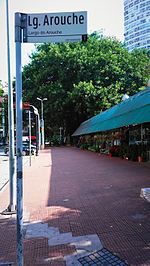Battle of Maria Antônia
1968 in BrazilConflicts in BrazilMilitary dictatorship in BrazilOctober 1968 events in South AmericaPortal templates with redlinked portals ... and 2 more
University of São PauloUnião Nacional dos Estudantes

The Battle of Maria Antônia (Portuguese: Batalha da Maria Antônia) was a conflict between students from the Faculty of Philosophy, Sciences and Letters of the University of São Paulo (FFCL-USP) and Mackenzie Presbyterian University that occurred on October 2, 1968. Both institutions were located on Maria Antônia Street, in central São Paulo, a popular venue for events such as protests and demonstrations.
Excerpt from the Wikipedia article Battle of Maria Antônia (License: CC BY-SA 3.0, Authors, Images).Battle of Maria Antônia
Rua Maria Antônia, São Paulo Higienópolis (Consolação)
Geographical coordinates (GPS) Address Nearby Places Show on map
Geographical coordinates (GPS)
| Latitude | Longitude |
|---|---|
| N -23.546111111111 ° | E -46.650833333333 ° |
Address
Centro Universitário Maria Antônia
Rua Maria Antônia
01222-010 São Paulo, Higienópolis (Consolação)
São Paulo, Brazil
Open on Google Maps








